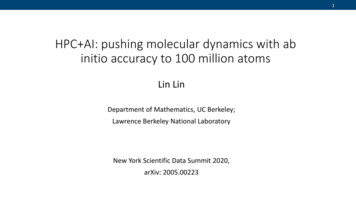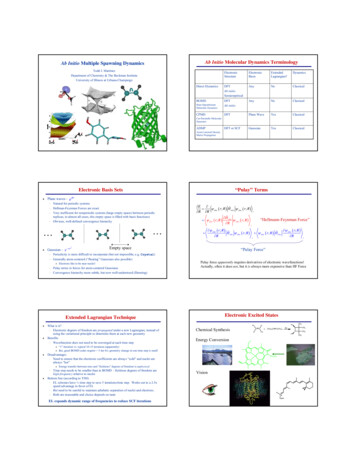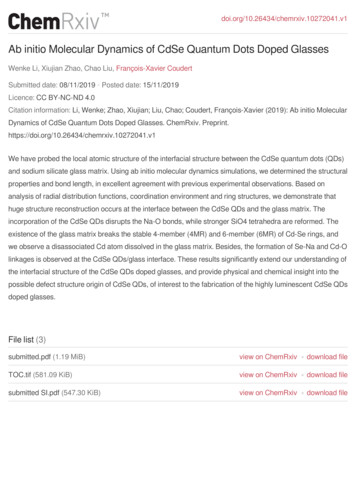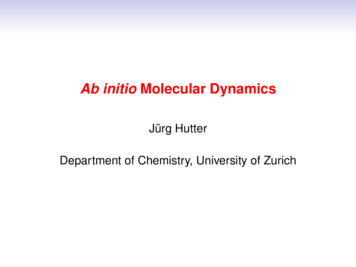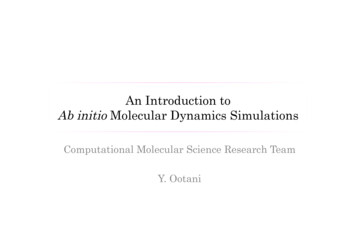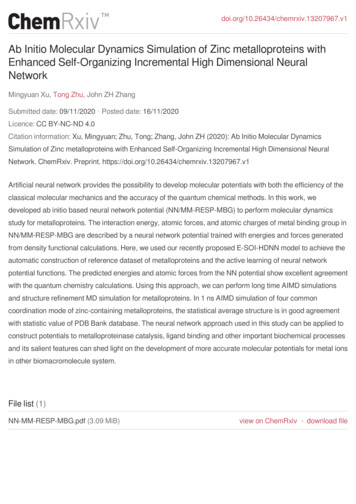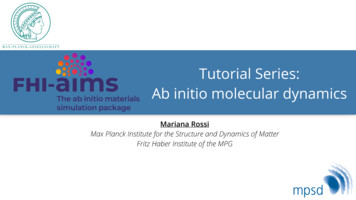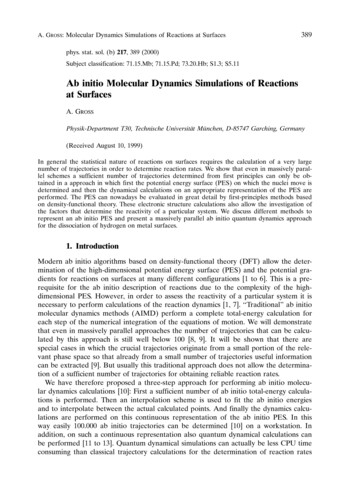
Transcription
John von Neumann Institute for ComputingAb initio molecular dynamics: Theory andImplementationDominik Marx and Jürg Hutterpublished inModern Methods and Algorithms of Quantum Chemistry,J. Grotendorst (Ed.), John von Neumann Institute for Computing,Jülich, NIC Series, Vol. 1, ISBN 3-00-005618-1, pp. 301-449, 2000.c 2000 by John von Neumann Institute for ComputingPermission to make digital or hard copies of portions of this work forpersonal or classroom use is granted provided that the copies are notmade or distributed for profit or commercial advantage and that copiesbear this notice and the full citation on the first page. To copy otherwiserequires prior specific permission by the publisher mentioned above.http://www.fz-juelich.de/nic-series/
AB INITIO MOLECULAR DYNAMICS:THEORY AND IMPLEMENTATIONDOMINIK MARXLehrstuhl für Theoretische Chemie, Ruhr–Universität BochumUniversitätsstrasse 150, 44780 Bochum, GermanyE–mail: dominik.marx@theochem.ruhr-uni-bochum.deJÜRG HUTTEROrganisch–chemisches Institut, Universität ZürichWinterthurerstrasse 190, 8057 Zürich, SwitzerlandE–mail: hutter@oci.unizh.chThe rapidly growing field of ab initio molecular dynamics is reviewed in the spiritof a series of lectures given at the Winterschool 2000 at the John von NeumannInstitute for Computing, Jülich. Several such molecular dynamics schemes arecompared which arise from following various approximations to the fully coupledSchrödinger equation for electrons and nuclei. Special focus is given to the Car–Parrinello method with discussion of both strengths and weaknesses in additionto its range of applicability. To shed light upon why the Car–Parrinello approachworks several alternate perspectives of the underlying ideas are presented. Theimplementation of ab initio molecular dynamics within the framework of planewave–pseudopotential density functional theory is given in detail, including diagonalization and minimization techniques as required for the Born–Oppenheimervariant. Efficient algorithms for the most important computational kernel routinesare presented. The adaptation of these routines to distributed memory parallelcomputers is discussed using the implementation within the computer code CPMDas an example. Several advanced techniques from the field of molecular dynamics, (constant temperature dynamics, constant pressure dynamics) and electronicstructure theory (free energy functional, excited states) are introduced. The combination of the path integral method with ab initio molecular dynamics is presentedin detail, showing its limitations and possible extensions. Finally, a wide range ofapplications from materials science to biochemistry is listed, which shows the enormous potential of ab initio molecular dynamics for both explaining and predictingproperties of molecules and materials on an atomic scale.1Setting the Stage: Why Ab Initio Molecular Dynamics ?Classical molecular dynamics using “predefined potentials”, either based on empirical data or on independent electronic structure calculations, is well established as a powerful tool to investigate many–body condensed matter systems.The broadness, diversity, and level of sophistication of this technique is documented in several monographs as well as proceedings of conferences and scientificschools 12,135,270,217,69,59,177. At the very heart of any molecular dynamics schemeis the question of how to describe – that is in practice how to approximate – theinteratomic interactions. The traditional route followed in molecular dynamics is todetermine these potentials in advance. Typically, the full interaction is broken upinto two–body, three–body and many–body contributions, long–range and short–range terms etc., which have to be represented by suitable functional forms, seeSect. 2 of Ref. 253 for a detailed account. After decades of intense research, veryelaborate interaction models including the non–trivial aspect to represent them1
analytically were devised 253,539,584.Despite overwhelming success – which will however not be praised in this review – the need to devise a “fixed model potential” implies serious drawbacks, seethe introduction sections of several earlier reviews 513,472 for a more complete digression on these aspects. Among the most delicate ones are systems where (i)many different atom or molecule types give rise to a myriad of different interatomicinteractions that have to be parameterized and / or (ii) the electronic structureand thus the bonding pattern changes qualitatively in the course of the simulation.These systems can be called “chemically complex”.The reign of traditional molecular dynamics and electronic structure methodswas greatly extended by the family of techniques that is called here “ab initiomolecular dynamics”. Other names that are currently in use are for instance Car–Parrinello, Hellmann–Feynman, first principles, quantum chemical, on–the–fly, direct, potential–free, quantum, etc. molecular dynamics. The basic idea underlyingevery ab initio molecular dynamics method is to compute the forces acting on thenuclei from electronic structure calculations that are performed “on–the–fly” as themolecular dynamics trajectory is generated. In this way, the electronic variables arenot integrated out beforehand, but are considered as active degrees of freedom. Thisimplies that, given a suitable approximate solution of the many–electron problem,also “chemically complex” systems can be handled by molecular dynamics. Butthis also implies that the approximation is shifted from the level of selecting themodel potential to the level of selecting a particular approximation for solving theSchrödinger equation.Applications of ab initio molecular dynamics are particularly widespread in materials science and chemistry, where the aforementioned difficulties (i) and (ii) areparticularly severe. A collection of problems that were already tackled by ab initiomolecular dynamics including the pertinent references can be found in Sect. 5. Thepower of this novel technique lead to an explosion of the activity in this field in termsof the number of published papers. The locus can be located in the late–eighties,see the squares in Fig. 1 that can be interpreted as a measure of the activity inthe area of ab initio molecular dynamics. As a matter of fact the time evolution ofthe number of citations of a particular paper, the one by Car and Parrinello from1985 entitled “Unified Approach for Molecular Dynamics and Density–FunctionalTheory” 108, parallels the trend in the entire field, see the circles in Fig. 1. Thus,the resonance that the Car and Parrinello paper evoked and the popularity of theentire field go hand in hand in the last decade. Incidentally, the 1985 paper by Carand Parrinello is the last one included in the section “Trends and Prospects” inthe reprint collection of “key papers” from the field of atomistic computer simulations 135. That the entire field of ab initio molecular dynamics has grown matureis also evidenced by a separate PACS classification number (71.15.Pd “ElectronicStructure: Molecular dynamics calculations (Car–Parrinello) and other numericalsimulations”) that was introduced in 1996 into the Physics and Astronomy Classification Scheme 486.Despite its obvious advantages, it is evident that a price has to be payed forputting molecular dynamics on ab initio grounds: the correlation lengths and relaxation times that are accessible are much smaller than what is affordable via2
2500Number2000CP PRL 1985AIMD1500100050001970198019902000Year nFigure 1. Publication and citation analysis. Squares: number of publications which appearedup to the year n that contain the keyword “ab initio molecular dynamics” (or synonyma suchas “first principles MD”, “Car–Parrinello simulations” etc.) in title, abstract or keyword list.Circles: number of publications which appeared up to the year n that cite the 1985 paper byCar and Parrinello 108 (including misspellings of the bibliographic reference). Self–citations andself–papers are excluded, i.e. citations of Ref. 108 in their own papers and papers coauthored byR. Car and / or M. Parrinello are not considered in the respective statistics. The analysis is basedon the CAPLUS (“Chemical Abstracts Plus”), INSPEC (“Physics Abstracts”), and SCI (“ScienceCitation Index”) data bases at STN International. Updated statistics from Ref. 405 .standard molecular dynamics. Another appealing feature of standard moleculardynamics is less evident, namely the “experimental aspect of playing with the potential”. Thus, tracing back the properties of a given system to a simple physicalpicture or mechanism is much harder in ab initio molecular dynamics. The brightside is that new phenomena, which were not forseen before starting the simulation,can simply happen if necessary. This gives ab initio molecular dynamics a trulypredictive power.Ab initio molecular dynamics can also be viewed from another corner, namelyfrom the field of classical trajectory calculations 649,541. In this approach, whichhas its origin in gas phase molecular dynamics, a global potential energy surfaceis constructed in a first step either empirically or based on electronic structurecalculations. In a second step, the dynamical evolution of the nuclei is generatedby using classical mechanics, quantum mechanics or semi / quasiclassical approximations of various sorts. In the case of using classical mechanics to describe thedynamics – the focus of the present overview – the limiting step for large systems is3
the first one, why so? There are 3N 6 internal degrees of freedom that span theglobal potential energy surface of an unconstrained N –body system. Using for simplicity 10 discretization points per coordinate implies that of the order of 10 3N 6electronic structure calculations are needed in order to map such a global potentialenergy surface. Thus, the computational workload for the first step grows roughlylike 10N with increasing system size. This is what might be called the “dimensionality bottleneck” of calculations that rely on global potential energy surfaces,see for instance the discussion on p. 420 in Ref. 254.What is needed in ab initio molecular dynamics instead? Suppose that a usefultrajectory consists of about 10M molecular dynamics steps, i.e. 10M electronicstructure calculations are needed to generate one trajectory. Furthermore, it isassumed that 10n independent trajectories are necessary in order to average overdifferent initial conditions so that 10 M n ab initio molecular dynamics steps arerequired in total. Finally, it is assumed that each single–point electronic structurecalculation needed to devise the global potential energy surface and one ab initiomolecular dynamics time step requires roughly the same amount of cpu time. Basedon this truly simplistic order of magnitude estimate, the advantage of ab initiomolecular dynamics vs. calculations relying on the computation of a global potentialenergy surface amounts to about 103N 6 M n. The crucial point is that for a givenstatistical accuracy (that is for M and n fixed and independent on N ) and for agiven electronic structure method, the computational advantage of “on–the–fly”approaches grows like 10N with system size.Of course, considerable progress has been achieved in trajectory calculations bycarefully selecting the discretization points and reducing their number, choosing sophisticated representations and internal coordinates, exploiting symmetry etc. butbasically the scaling 10N with the number of nuclei remains a problem. Otherstrategies consist for instance in reducing the number of active degrees of freedomby constraining certain internal coordinates, representing less important ones by a(harmonic) bath or friction, or building up the global potential energy surface interms of few–body fragments. All these approaches, however, invoke approximations beyond the ones of the electronic structure method itself. Finally, it is evidentthat the computational advantage of the “on–the–fly” approaches diminish as moreand more trajectories are needed for a given (small) system. For instance extensiveaveraging over many different initial conditions is required in order to calculatequantitatively scattering or reactive cross sections. Summarizing this discussion,it can be concluded that ab initio molecular dynamics is the method of choice toinvestigate large and “chemically complex” systems.Quite a few review articles dealing with ab initio molecular dynamics appearedin the nineties 513,223,472,457,224,158,643,234,463,538,405 and the interested reader is referred to them for various complementary viewpoints. In the present overviewarticle, emphasis is put on both broadness of the approaches and depth of the presentation. Concerning the broadness, the discussion starts from the Schrödingerequation. Classical, Ehrenfest, Born–Oppenheimer, and Car–Parrinello moleculardynamics are “derived” from the time–dependent mean–field approach that is obtained after separating the nuclear and electronic degrees of freedom. The mostextensive discussion is related to the features of the basic Car–Parrinello approach4
but all three ab initio approaches to molecular dynamics are contrasted and partlycompared. The important issue of how to obtain the correct forces in these schemesis discussed in some depth. The most popular electronic structure theories implemented within ab initio molecular dynamics, density functional theory in the firstplace but also the Hartree–Fock approach, are sketched. Some attention is alsogiven to another important ingredient in ab initio molecular dynamics, the choiceof the basis set.Concerning the depth, the focus of the present discussion is clearly the implementation of both the basic Car–Parrinello and Born–Oppenheimer moleculardynamics schemes in the CPMD package 142. The electronic structure approachin CPMD is Hohenberg–Kohn–Sham density functional theory within a plane wave/ pseudopotential implementation and the Generalized Gradient Approximation.The formulae for energies, forces, stress, pseudopotentials, boundary conditions,optimization procedures, parallelization etc. are given for this particular choice tosolve the electronic structure problem. One should, however, keep in mind thata variety of other powerful ab initio molecular dynamics codes are available (forinstance CASTEP 116, CP-PAW 143, fhi98md 189, NWChem 446, VASP 663) which arepartly based on very similar techniques. The classic Car–Parrinello approach 108is then extended to other ensembles than the microcanonical one, other electronicstates than the ground state, and to a fully quantum–mechanical representation ofthe nuclei. Finally, the wealth of problems that can be addressed using ab initiomolecular dynamics is briefly sketched at the end, which also serves implicitly asthe “Summary and Conclusions” section.22.1Basic Techniques: TheoryDeriving Classical Molecular DynamicsThe starting point of the following discussion is non–relativistic quantum mechanicsas formalized via the time–dependent Schrödinger equationi Φ({ri }, {RI }; t) HΦ({ri }, {RI }; t) t(1)in its position representation in conjunction with the standard HamiltonianH XIXIXI22MI22MI22MI 2I 2I XiXi22me22me 2i Xi jX e2 Z IX e2 ZI ZJe2 ri rj RI ri RI RJ I,iI J 2i Vn e ({ri }, {RI }) 2I He ({ri }, {RI })(2)for the electronic {ri} and nuclear {RI } degrees of freedom. The more convenientatomic units (a.u.) will be introduced at a later stage for reasons that will soonbecome clear. Thus, only the bare electron–electron, electron–nuclear, and nuclear–nuclear Coulomb interactions are taken into account.5
The goal of this section is to derive classical molecular dynamics 12,270,217starting from Schrödinger’s wave equation and following the elegant route ofTully 650,651. To this end, the nuclear and electronic contributions to the totalwavefunction Φ({ri}, {RI }; t), which depends on both the nuclear and electroniccoordinates, have to be separated. The simplest possible form is a product ansatz Z ti00dt Ẽe (t ) ,(3)Φ({ri}, {RI }; t) Ψ({ri}; t) χ({RI }; t) expt0where the nuclear and electronic wavefunctions are separately normalized to unityat every instant of time, i.e. hχ; t χ; ti 1 and hΨ; t Ψ; ti 1, respectively. Inaddition, a convenient phase factorZẼe drdR Ψ? ({ri }; t) χ? ({RI }; t) He Ψ({ri}; t) χ({RI }; t)(4)Rwas introduced at this stage such that the final equations will look nice; drdRrefers to the integration over all i 1, . . . and I 1, . . . variables {r i} and {RI },respectively. It is mentioned in passing that this approximation is called a one–determinant or single–configuration ansatz for the total wavefunction, which at theend must lead to a mean–field description of the coupled dynamics. Note also thatthis product ansatz (excluding the phase factor) differs from the Born–Oppenheimeransatz 340,350 for separating the fast and slow variablesΦBO ({ri}, {RI }; t) Xk 0Ψ̃k ({ri}, {RI })χ̃k ({RI }; t)(5)even in its one–determinant limit, where only a single electronic state k (evaluatedfor the nuclear configuration {RI }) is included in the expansion.Inserting the separation ansatz Eq. (3) into Eqs. (1)–(2) yields (after multiplyingfrom the left by hΨ and hχ and imposing energy conservation d hHi /dt 0) thefollowing relations ZX 2 Ψ?2idR χ ({RI }; t)Vn e ({ri}, {RI })χ({RI }; t) Ψ (6) Ψ t2me ii Z X 2 χ2?i χ dr Ψ ({ri}; t)He({ri }, {RI })Ψ({ri}; t) χ .(7) t2MI IIThis set of coupled equations defines the basis of the time–dependent self–consistentfield (TDSCF) method introduced as early as 1930 by Dirac 162, see also Ref. 158.Both electrons and nuclei move quantum–mechanically in time–dependent effectivepotentials (or self–consistently obtained average fields) obtained from appropriateaverages (quantum mechanical expectation values h. . . i) over the other class ofdegrees of freedom (by using the nuclear and electronic wavefunctions, respectively).Thus, the single–determinant ansatz Eq. (3) produces, as already anticipated, amean–field description of the coupled nuclear–electronic quantum dynamics. Thisis the price to pay for the simplest possible separation of electronic and nuclearvariables.6
The next step in the derivation of classical molecular dynamics is the task toapproximate the nuclei as classical point particles. How can this be achieved in theframework of the TDSCF approach, given one quantum–mechanical wave equation describing all nuclei? A well–known route to extract classical mechanics fromquantum mechanics in general starts with rewriting the corresponding wavefunctionχ({RI }; t) A({RI }; t) exp [iS({RI }; t)/ ](8)in terms of an amplitude factor A and a phase S which are both considered to bereal and A 0 in this polar representation, see for instance Refs. 163,425,535. Aftertransforming the nuclear wavefunction in Eq. (7) accordingly and after separatingthe real and imaginary parts, the TDSCF equation for the nucleiZX 1X 1 2 A S2I ( I S) dr Ψ? HeΨ 2(9) t2MI2MI AIIX 1 A X 1 ( I A) ( I S) A 2I S 0(10) tMI2MIIIis (exactly) re–expressed in terms of the new variables A and S. This so–called“quantum fluid dynamical representation” Eqs. (9)–(10) can actually be used tosolve the time–dependent Schrödinger equation 160. The relation for A, Eq. (10),can be rewritten as a continuity equation 163,425,535 with the help of the identification of the nuclear density χ 2 A2 as directly obtained from the definitionEq. (8). This continuity equation is independent of and ensures locally the conservation of the particle probability χ 2 associated to the nuclei in the presence ofa flux.More important for the present purpose is a more detailed discussion of therelation for S, Eq. (9). This equation contains one term that depends on , acontribution that vanishes if the classical limitZX 1 S2 ( I S) dr Ψ? He Ψ 0(11) t2MIIis taken as 0; an expansion in terms of would lead to a hierarchy of semiclassical methods 425,259. The resulting equation is now isomorphic to equations ofmotion in the Hamilton–Jacobi formulation 244,540 S H ({RI }, { I S}) 0 t(12)of classical mechanics with the classical Hamilton functionH({RI }, {PI }) T ({PI }) V ({RI })(13)defined in terms of (generalized) coordinates {R I } and their conjugate momenta{PI }. With the help of the connecting transformationPI I S7(14)
the Newtonian equation of motion ṖI I V ({RI }) corresponding to Eq. (11)ZdPI I dr Ψ? He ΨordtZ(15)MI R̈I (t) I dr Ψ? He Ψ I VeE ({RI (t)})(16)can be read off. Thus, the nuclei move according to classical mechanics in aneffective potential VeE due to the electrons. This potential is a function of only thenuclear positions at time t as a result of averaging H e over the electronic degreesof freedom, i.e. computing its quantum expectation value hΨ H e Ψi, while keepingthe nuclear positions fixed at their instantaneous values {R I (t)}.However, the nuclear wavefunction still occurs in the TDSCF equation for theelectronic degrees of freedom and has to be replaced by the positions of the nuclei forconsistency. In this case the classical reduction can be achieved simply by replacing2the nuclearQdensity χ({RI }; t) in Eq. (6) in the limit 0 by a product of deltafunctions I δ(RI RI (t)) centered at the instantaneous positions {R I (t)} of theclassical nuclei as given by Eq. (15). This yields e.g. for the position operatorZ 0dR χ? ({RI }; t) RI χ({RI }; t) RI (t)(17) the required expectation value. This classical limit leads to a time–dependent waveequation for the electronsiX 2 Ψ 2i Ψ Vn e ({ri }, {RI (t)})Ψ t2mei He ({ri}, {RI (t)}) Ψ({ri}, {RI }; t)(18)which evolve self–consistently as the classical nuclei are propagated via Eq. (15).Note that now He and thus Ψ depend parametrically on the classical nuclear positions {RI (t)} at time t through Vn e ({ri}, {RI (t)}). This means that feedbackbetween the classical and quantum degrees of freedom is incorporated in bothdirections (at variance with the “classical path” or Mott non–SCF approach todynamics 650,651).The approach relying on solving Eq. (15) together with Eq. (18) is sometimescalled “Ehrenfest molecular dynamics” in honor of Ehrenfest who was the first toaddress the question a of how Newtonian classical dynamics can be derived fromSchrödinger’s wave equation 174. In the present case this leads to a hybrid ormixed approach because only the nuclei are forced to behave like classical particles,whereas the electrons are still treated as quantum objects.Although the TDSCF approach underlying Ehrenfest molecular dynamicsclearly is a mean–field theory, transitions between electronic states are includeda Theopening statement of Ehrenfest’s famous 1927 paper 174 reads:“Es ist wünschenswert, die folgende Frage möglichst elementar beantworten zu können: WelcherRückblick ergibt sich vom Standpunkt der Quantenmechanik auf die Newtonschen Grundgleichungen der klassischen Mechanik?”8
in this scheme. This can be made evident by expanding the electronic wavefunction Ψ (as opposed to the total wavefunction Φ according to Eq. (5)) in terms ofmany electronic states or determinants ΨkΨ({ri}, {RI }; t) Xk 0ck (t)Ψk ({ri}; {RI })(19)withcoefficients {ck (t)}. In this case, the coefficients { ck(t) 2 } (withP complex2k ck (t) 1) describe explicitly the time evolution of the populations (occupations) of the different states {k} whereas interferences are included via the {c ?k cl6 k }contributions. One possible choice for the basis functions {Ψ k } is the adiabatic basisobtained from solving the time–independent electronic Schrödinger equationHe ({ri }; {RI })Ψk Ek ({RI })Ψk ({ri}; {RI }) ,(20)where {RI } are the instantaneous nuclear positions at time t according to Eq. (15).The actual equations of motion in terms of the expansion coefficients {c k } arepresented in Sect. 2.2.At this stage a further simplification can be invoked by restricting the totalelectronic wave function Ψ to be the ground state wave function Ψ 0 of He at eachinstant of time according to Eq. (20) and c 0(t) 2 1 in Eq. (19). This should be agood approximation if the energy difference between Ψ 0 and the first excited stateΨ1 is everywhere large compared to the thermal energy k B T , roughly speaking. Inthis limit the nuclei move according to Eq. (15) on a single potential energy surfaceZEVe dr Ψ?0 He Ψ0 E0({RI })(21)that can be computed by solving the time–independent electronic Schrödinger equation Eq. (20)He Ψ0 E0Ψ0 ,(22)for the ground state only. This leads to the identification V eE E0 via Eq. (21),i.e. in this limit the Ehrenfest potential is identical to the ground–state Born–Oppenheimer potential.As a consequence of this observation, it is conceivable to decouple the task ofgenerating the nuclear dynamics from the task of computing the potential energysurface. In a first step E0 is computed for many nuclear configurations by solvingEq. (22). In a second step, these data points are fitted to an analytical functionalform to yield a global potential energy surface 539, from which the gradients can beobtained analytically. In a third step, the Newtonian equation of motion Eq. (16)is solved on this surface for many different initial conditions, producing a “swarm”of classical trajectories. This is, in a nutshell, the basis of classical trajectory calculations on global potential energy surfaces 649,541.As already alluded to in the general introduction, such approaches suffer severelyfrom the “dimensionality bottleneck” as the number of active nuclear degrees offreedom increases. One traditional way out of this dilemma is to approximate the9
global potential energy surfaceVeE Veapprox ({RI }) NXv1(RI ) v2 (RI , RJ )I JI 1 NXNXI J Kv3(RI , RJ , RK ) · · ·(23)in terms of a truncated expansion of many–body contributions 253,12,270. At thisstage, the electronic degrees of freedom are replaced by interaction potentials {v n }and are not featured as explicit degrees of freedom in the equations of motion. Thus,the mixed quantum / classical problem is reduced to purely classical mechanics,once the {vn } are determined. Classical molecular dynamicsMI R̈I (t) I Veapprox ({RI (t)})(24)relies crucially on this idea, where typically only two–body v 2 or three–body v3interactions are taken into account 12,270, although more sophisticated models toinclude non–additive interactions such as polarization exist. This amounts to adramatic simplification and removes the dimensionality bottleneck as the globalpotential surface is constructed from a manageable sum of additive few–body contributions — at the price of introducing a drastic approximation and of basicallyexcluding chemical transformations from the realm of simulations.As a result of this derivation, the essential assumptions underlying classicalmolecular dynamics become transparent: the electrons follow adiabatically the classical nuclear motion and can be integrated out so that the nuclei evolve on a singleBorn–Oppenheimer potential energy surface (typically but not necessarily given bythe electronic ground state), which is in general approximated in terms of few–bodyinteractions.Actually, classical molecular dynamics for many–body systems is only madepossible by somehow decomposing the global potential energy. In order to illustratethis point consider the simulation of N 500 Argon atoms in the liquid phase 175where the interactionsPcan faithfully be described by additive two–body terms,i.e. Veapprox ({RI }) NI J v2 ( RI RJ ). Thus, the determination of the pairpotential v2 from ab initio electronic structure calculations amounts to computingand fitting a one–dimensional function. The corresponding task to determine aglobal potential energy surface amounts to doing that in about 10 1500 dimensions,which is simply impossible (and on top of that not necessary for Nobel gases!).2.2Ehrenfest Molecular DynamicsA way out of the dimensionality bottleneck other than to approximate the globalpotential energy surface Eq. (23) or to reduce the number of active degrees of freedom is to take seriously the classical nuclei approximation to the TDSCF equations,Eq. (15) and (18). This amounts to computing the Ehrenfest force by actually solv-10
ing numericallyMI R̈I (t) IZdr Ψ? He Ψ I hΨ He Ψi(25) He Ψ(26) I hHe i I VeE"#X 2 Ψi 2 Vn e ({ri}, {RI (t)}) Ψ t2me iithe coupled set of equations simultaneously. Thereby, the a priori constructionof any type of potential energy surface is avoided from the outset by solving thetime–dependent electronic Schrödinger equation “on–the–fly”. This allows one tocompute the force from I hHe i for each configuration {RI (t)} generated by molecular dynamics; see Sect. 2.5 for the issue of using the so–called “Hellmann–Feynmanforces” instead.The corresponding equations of motion in terms of the adiabatic basis Eq. (20)and the time–dependent expansion coefficients Eq. (19) read 650,651XXc?k cl (Ek El ) dkl(27) ck (t) 2 I Ek MI R̈I (t) Iki ċk (t) ck (t)Ek iXk,lcl (t)ṘI dklI ,(28)Z(29)I,lwhere the coupling terms are given bydklI ({RI (t)}) dr Ψ?k I Ψlwith the property dkkI 0. The Ehrenfest approach is thus seen to include rigorously non–adiabatic transitions between different electronic states Ψ k and Ψl withinthe framework of classical nuclear motion and the mean–field (TDSCF) approximation to the electronic structure, see e.g. Refs. 650,651 for reviews and for instanceRef. 532 for an implementation in terms of time–dependent density functional theory.The restriction to one electronic state in the expansion Eq. (19), which is inmost cases the ground state Ψ0 , leads toMI R̈I (t) I hΨ0 He Ψ0 i Ψ0 He Ψ0i t(30)(31)as a special case of Eqs. (25)–(26); note that H e is time–dependent via the nuclearcoordinates {RI (t)}. A point worth mentioning here is that the propaga
Ab initio molecular dynamics can also be viewed from another corner, namely from the eld of classical trajectory calculations 649;541. In this approach, which has its origin in gas phase molecular dynamics, a global potential energy surface is constructed in a rst step either empirically or based on electronic structure calculations. In a second step, the dynamical evolution of the nuclei is .

